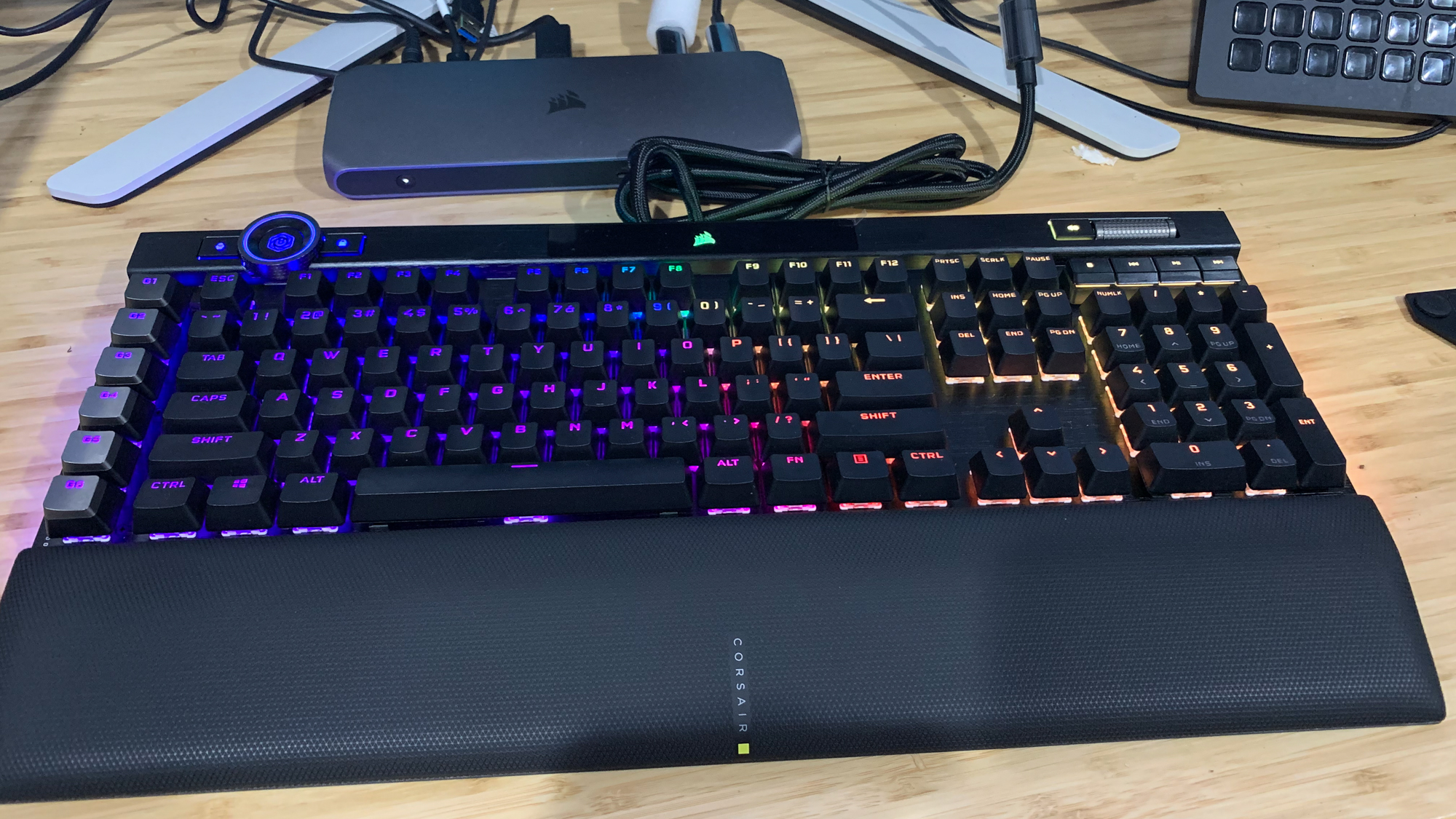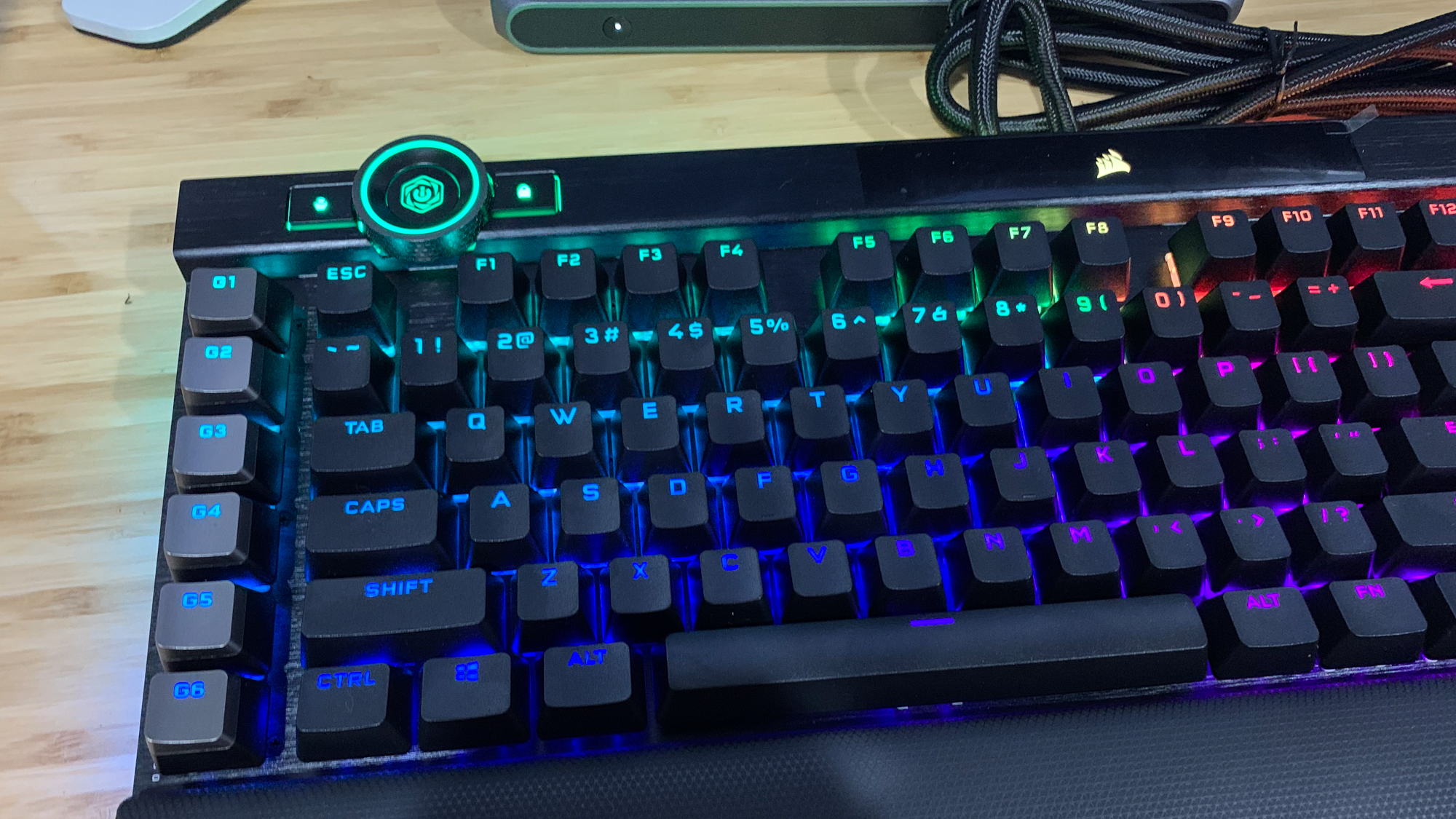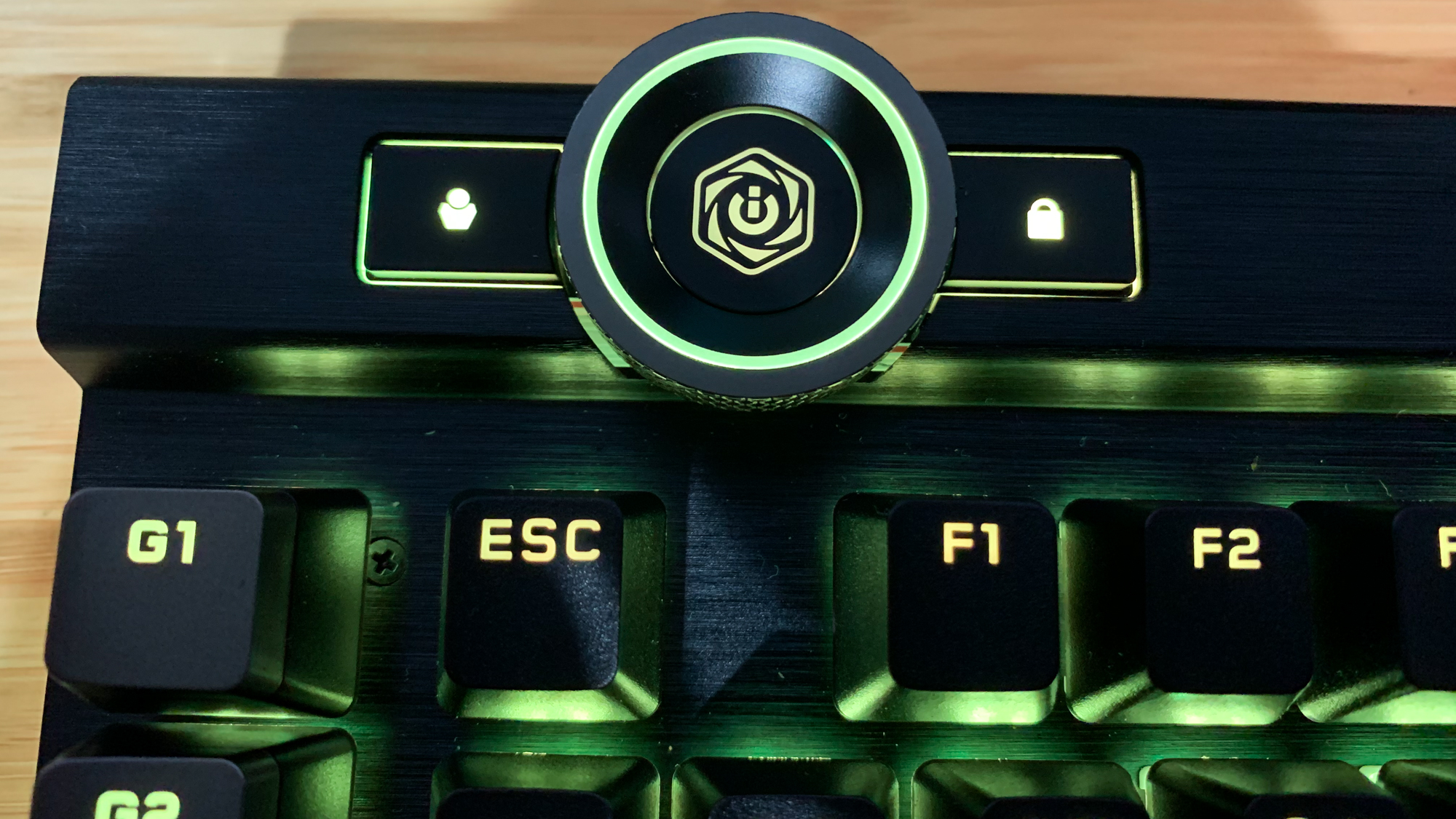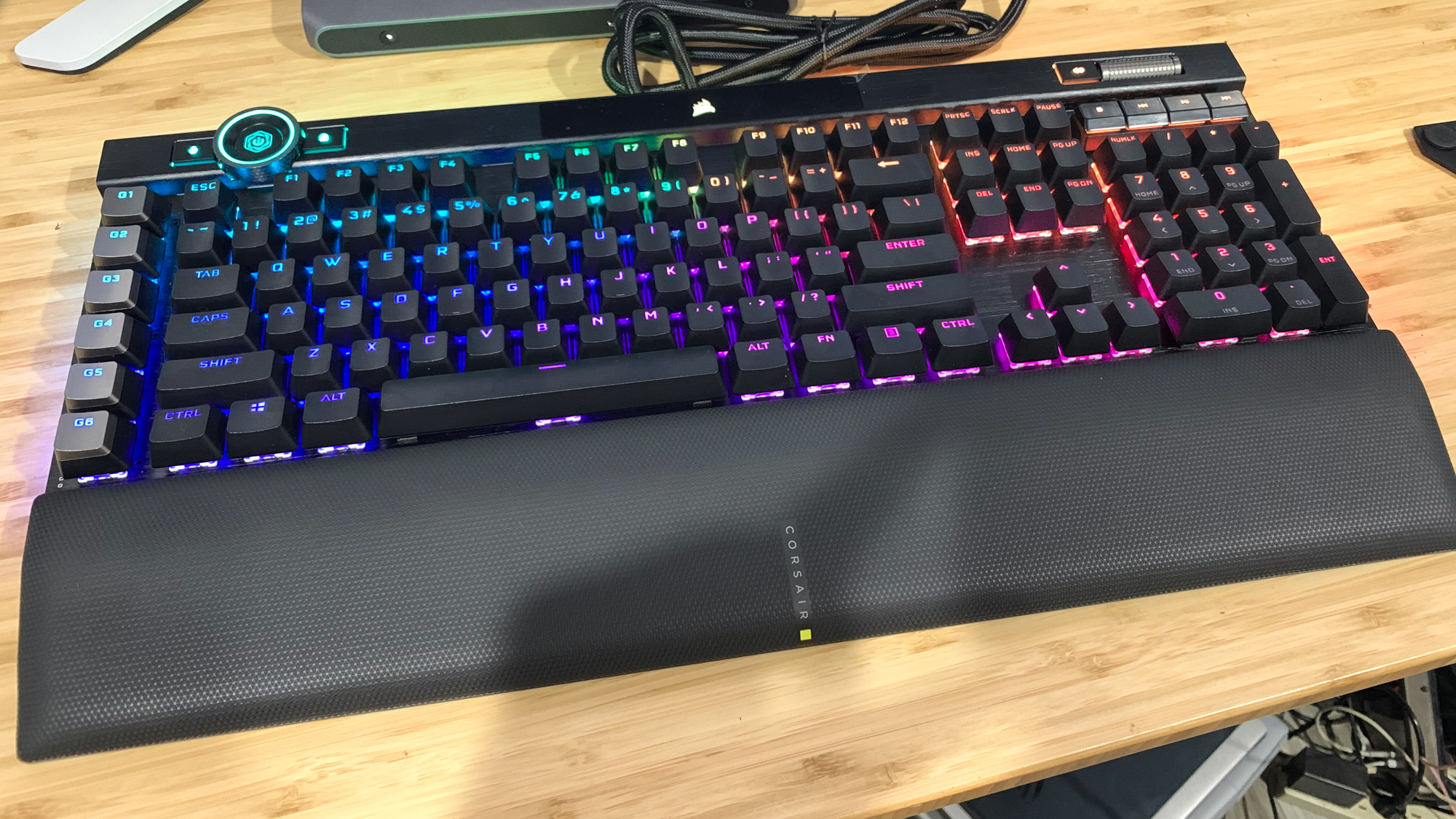Laptop Mag Verdict
The Corsair K100 RGB Gaming keyboard bundles blazing-fast input speeds, lots of functionality and customization in a premium frame.
Pros
- +
Premium attractive build
- +
Comfortable typing experience
- +
Blazing fast key inputs
- +
Tons of functionality and customization options
Cons
- -
Pricy
- -
OPX keys need getting used to
Why you can trust Laptop Mag
Corsair already made great gaming keyboards. But the company is leveling up even further with its latest keyboard, the K100. Priced at $229, the K100 RGB Mechanical Gaming is Corsair’s first keyboard to feature Optical-Mechanical switches, which use light technology for fast key inputs. This is also the first showing for the company’s iCue Control wheel, which gives gamers and multimedia mavens a host of functionality on the fly. You’ve got all this functionality housed in a metal and plastic frame that’s rated for longevity and comfort.
The new switches do take some getting used to, especially for those who use a traditional mechanical keyboard. And the price is nothing to sneeze at either. But for gamers looking for esports-level equipment, the Corsair K100 keyboard has earned a spot on our Best gaming keyboards page and should sit at the top of your list.
Corsair K100 RGB Mechanical Gaming Keyboard pricing and configuration
There are currently two versions of the Corsair K100 available and both of them cost $229. The difference between the two lies underneath the keycaps. One version of the keyboard uses Optical-Mechanical (OPX) switches while the other is equipped with mechanical Cherry MX Speed switches.
Corsair K100 RGB Mechanical Gaming Keyboard design
One thing’s for sure, Corsair doesn’t know how to make an ugly keyboard. The K100’s deck is made of black brushed anodized aluminum. The black keycaps, built with PBT(Polybutylene terephthalate), are precision molded to resist long-term wear and tear.
At the top center of the deck is a wide glossy panel with the Corsair logo. You have a pair of indicators signaling Macro, Mute and Win Lock on the left half of the panel and Num, Caps and Scroll lock on the right. The iCue Control Wheel sits in the left corner flanked by the Profile Switch and Windows Lock key. The wheel key button sits in the center. In the right corner, you have the volume roller next to the mute key. Both the scroll and iCue Control wheel have fine grooves carved into the side that gently catch onto your finger as you're turning them for a smooth movement. It’s a nice, subtle touch.
There’s a thick braided cable coming out the top of the keyboard that splits into two USB Type-A inputs for use with a PC, Mac or an Xbox One. A USB 2.0 port sits directly to the right.
The bottom of the keyboard is made of black plastic with the four corners reinforced with a soft touch material. A pair of retractable feet in the bottom corners raise the keyboard on a slight angle for more comfortable typing.
Sign up to receive The Snapshot, a free special dispatch from Laptop Mag, in your inbox.
Speaking of comfort, the K100 ships with a magnetic detachable memory foam palm rest. Covered in a leatherette weave-like pattern, the palm rest is squishy, but firm for a much more comfortable typing experience.
All that hardware means that the 18.5 x 6.5 x 1.5-inch K100 is a bit on the heavy side at 2.9 pounds.
Corsair K100 RGB Mechanical Gaming Keyboard keys
The K100 has 110 keys, or 118 if you count the media keys and the ones at the top of the keyboard. As you’d expect from a premium gaming keyboard, the K100 is bursting with gamer-centric extras including a row of Macro, arrow, function and Num keys. And then you’ve got media keys to play/pause and skip tracks when you’re listening to music, keys to mute the audio and enable/disable certain functionality.
And while that’s all well and good, what you really want to know is how those OPX RGB keys feel. After all, this is the first Corsair keyboard to utilize the technology. The answer: extremely sensitive with a good amount of clickiness. Are they Cherry Blue switches? Absolutely not, but my fingertips still gave a performance on those keys that the late, great Gregory Hines would be proud of. Thanks to their 1-millimeter actuation and 3.2mm of key travel, they’re bouncy with plenty of space for my fingertips to rest on.
Typing on the K100 does take some getting used to, especially when your bread and butter is laptops. But thanks to the 1-millimeter actuation and 3.2mm of key travel, I quickly became acclimated. Unlike mechanical keys where you need to fully depress the keys to register a keystroke, the point of actuation for optical-mechanical switches is actually a beam of light. Essentially, when the beam is broken, your input is registered. It’s not typing at the speed of light, but when coupled with Corsair’s Axon Hyper-Processing technology ,which has a 4,000Hz polling rate (the rate of speed the computer checks the USB bus for data), it might as well be. According to Corsair, its Axon technology registers keystrokes 4x faster than your average mechanical switches.
Corsair K100 RGB Mechanical Gaming Keyboard performance
After a few tries, I hit 80 words per minute on the 10fastfingers typing test, which is well above my 70-wpm average. That should give most touch typists reason to rejoice; this glowing tactile spectacle is designed for gaming –– from its row of Macro keys down to its Numpad.
When I played Wolfenstein: The New Colossus, I didn’t notice too much of a difference in input lag, but when the difference is fractions of a millisecond, it’s probably beyond me. I definitely felt like my movements were smoother and I was getting the drop on enemies more than I’m used to, but I can’t put my finger on what exactly changed.
I had the same experience when I played Battlefield V. And when I went questing in Witcher 3: The Wild Hunt, I definitely noticed that Geralt’s dodges were slightly quicker than normal. And when I played Control, I was launching bric-a-brac like a mad woman. Still, a lot of the improvement is subtle and is something more geared toward an esports professional.
Corsair K100 RGB Mechanical Gaming Keyboard features
If you’ve used a high-end mechanical keyboard, you’re familiar with Macro and media keys, and you’ve probably come in contact with an integrated scroll wheel. But what’s new is the iCue Control wheel that allows you to access a number of different modes in case you don’t feel like fiddling with the iCue software.
For example, I could adjust the brightness level on the RGB lighting. And once I was done, a quick press of the central button allowed me to skip, fast forward or rewind tracks. You can even use the wheel to zoom in and out or launch Macro recording mode. Or you can program additional functionality using the iCue software.
Corsair K100 RGB Mechanical Gaming Keyboard software
Like most Corsair products, the K100 works with the company’s proprietary iCue software, which allows you to customize and program compatible products to your heart’s content. With the K100, its per-key lighting can get granular, and when you throw in several profiles, things can get overwhelming rather quickly. Thankfully, iCue’s user interface is clean and easy to use.
For instance, the K100 has two sets of profiles: hardware and software. Hardware profiles are what the keyboard uses when the iCue software isn’t running. Depending on how complex your profiles are, you can store up to 200 by way of the K100’s 8MB of onboard storage. Conversely, software profiles take priority when the iCue software is running. Whether it’s a hardware or software profile, once you start fiddling around, you have the option to program the lighting, Macro and hotkeys as well as the iCue Control Wheel.
And if you happen to own an Elgato Stream Deck or Stream Deck XL, you can set additional Macro and G-Key functionality, provided you have both the iCue and Steam Deck software running. Keep in mind, however, that if you’re using the Stream Deck, it overrides any functionality you normally have set up for the Macro keys.
But if you’re not in the mood to do all that fine tuning, the K100 comes pre-programmed with some functionality, including cycling through lighting profiles via hotkeys.
Bottom line
As a person who loves having all the bells, whistles and flashing lights, the Corsair K100 RGB Mechanical Gaming keyboard is right up my alley. For $229, you get a premium gaming keyboard that’s packed to the gills with features. Although they take some getting used to, the Optical-Mechanical OPX keys deliver lightning-fast input as well as a comfortable typing experience. The new iCue Control wheel and media keys offer a bunch of cool functionality, which can enhance your productivity and multimedia experience.
Plus, with its double-molded keycaps, aluminum construction and extra bright RGB lighting, the K100 looks every bit like a high-end peripheral. However, $229 is a lot to ask if you’re not going to use all that functionality. Entry-level gamers might be happier with something like the $38 VictSing PC259A. But gamers who are looking to upgrade their gaming experience should look no further than the Corsair K100 keyboard.

Sherri L. Smith has been cranking out product reviews for Laptopmag.com since 2011. In that time, she's reviewed more than her share of laptops, tablets, smartphones and everything in between. The resident gamer and audio junkie, Sherri was previously a managing editor for Black Web 2.0 and contributed to BET.Com and Popgadget.






